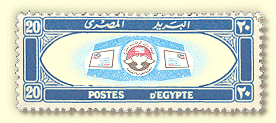

| Fundamental postmarks showing the basic Blomfield types and numbers |
| Type I 1 |
 |
Egypt's first circular datestamp, introduced in 1865, with the inscription in Italian: Posta Vice-Reali Egiziane |
| Type II 2-n |
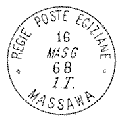 |
In 1867 the inscription Regie (Royal) Post Egiziane was introduced. The Regie was removed within months to appease the Sultan of Turkey |
| Type III 2.5n |
 |
The datestamp with V.R.(Vice-Reali, ie, Vice-Regal) Poste Egiziane was introduced in 1869 to replace the earlier types. |
| Type IV 3n |
 |
In 1873 a type with Posta Khedeuie (ie, Khedivial) Egiziane appeared, some with double rings. |
| Type V 1 |
 |
1874 saw the introduction of handstamps inscribed with simply Poste Egiziane; some of those for Upper Egypt also had the place name in Arabic |
| Type VI 2.2n |
 |
When Caillard Pasha was appointed Postmaster General the basic language was change to French. The first Postes Egyptiennes handstamps were put into use in 1877. |
| Type VII 1 |
 |
In 1878 a killer type with Arabic appeared similar in design to the contemporary British postmark. This type has been seen only for Alexandria |
| Type VIII 1 |
 |
This simple design of Roman (French or English) over Arabic was introduced in 1880 and continued in use for many years. |
| Type IX 0.5 |
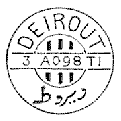 |
In the early 1880s a postmark with vertical bars in the inner ring was introduced. This is sometimes referred to as the Swiss Type. Some do not have an inner ring or have bars only in one half or other. |
| Type X 1 |
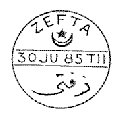 |
The Star and Crescent postmark was introduced in 1882 and was used in fewer than 40 locations, some of them in Sudan. The last recorded use is 1919. |
| Type XI 1 |
 |
Star without crescent types were used from 1907 until 1923. The type as shown is more popularly known as the star and bridge. |
| Type XII 2.2 |
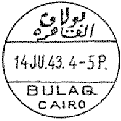 |
Similar to type VII but after declaration of the Kingdom in March 1922 the style with Arabic over the Roman was gradually introduced. |
| Intaglio Seals Seal-A4 |
 |
The original intaglio seals stem from the post of Mohammed Ali, being used on stampless covers from the 1850s. Later types appeared in 1866, a few containing a star and crescent. Possibly intended as seals for wax, they are also found cancelling stamps. |
| Postmarks for Specific Purposes |
| Air Mail AMA-5 |
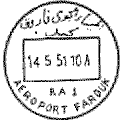 |
The first Air Mail postmark is the one emanating from the Heliopolis Air Meeting of 1910. Inscribed HELIOPOLIS AERODROME, this is mostly found on souvenir postcards. The first Air Mail service was the Cairo-India route via Baghdad which began in 1918. |
| Arrival Arr-9.55 |
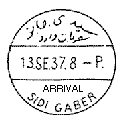 |
Arrival postmarks appeared in the late 1880s in larger offices as a backstamp to signify date of receipt. Used also for postage due cancellations. |
| Cash Cas-12.15 |
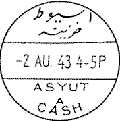 |
First used in the late 1890s, these were used for cancelling stamps on receipts and packets/envelopes that were handed over at the counter. Also found on postal orders. |
| COD and Collection-Order PP-6 |
 |
Known soon after the turn of the century for packets that were sent COD and bills to be paid to the sender |
| Commemorative Com-4.1 |
 |
These are not commemorative postmarks as such and the name Special Events would be more apt. Ignoring the Heliopolis Air Meeting cancel, the first recognised Special Event is the Geographical Congress of 1924. Many more were to follow. |
| Customs Service CD-4 |
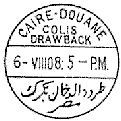 |
Customs (in French Douane) marks appeared at the turn of the century, principally for use on exported parcels. Some contain the word drawback, used when the sender of cigarettes could claim back import duty paid on the raw tobacco from which they had been made. |
| Delivery ExD-9 |
 |
Delivery seems to serve a purpose very similar to that of Express, though the first recorded Delivery postmark is Oct.23 1906 and the express service was inaugurated only on Sept. 20 1922. Perhaps the early Delivery marks were used in the house to house service? Some later marks contain both the words delivery and express (1940-1978), and others House to House Delivery (1948). |
| Departure Dep-1.5 |
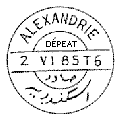 |
The first recorded use of postmarks containing Départ (French) or Depart is 1880. Usage is uncertain - aren't nearly all postmarks indicating the point of departure? - but possibly to indicate departure overseas. |
| Government Service GS-1 |
 |
Issued from the early 1880s, these were used strictly only on mail emanating from a government office. Included in this group are postmarks with specific named governmental organisations. |
| Machine Cancels | 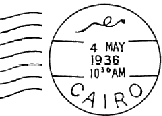 |
The first machine franking in Egypt was introduced in 1922. |
| Money Orders Cas-8 |
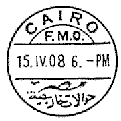 |
Introduced in 1881 for international money orders. Initially included among the cash postmarks by Blomfield, hence the Cas type number. |
| Parcels PP-5.3 |
 |
Introduced in the mid-1880s, these were issued to a post office parcels counter. As this was often the same as for registered mail, dual purpose cancels also exist with the letters R&P or the equivalent in Arabic. |
| Postal Service PS-12 |
 |
These markings were used by the postal service itself for administration purposes and are rarely found cancelling stamps. The most common use is on interpostals |
| Postman PM-2 |
 |
The Postmen cancels are mostly found as backstamps, possibly as an indication of personal handling. Perhaps somehow connected to the Express service |
| Proprietary PPO ? |
 |
Originally designated Proprietary Post Offices (later found to be a misnomer), these comprise mainly Hotel postmarks. The Hotels have been studied fairly extensively and are no longer referred to by their Blomfield type. The example shown postdates Blomfield's study, which would have given it a PPO number; it is now HL2 (ie, Hotel Luxor type 2). The latest report in the QC, Sept.2000, contains over 100 drawings with earliest and latest dates. |
| Registration Reg-19.3 |
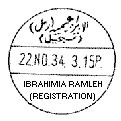 |
These were used to cancel registered mail and covers. Often used with an accompanying rectangular boxed registration cachet with a large R. |
| Rettas B-1 |
 |
Rettas or dumb cancellations are recorded from 1866, at first used to cancel the stamp with the postmark struck elsewhere on the envelope. This practice was later abandoned in favour of the cancel alone. Rettas continued in use to cancel stamps that had missed being cancelled at the point of origin, and often also to cancel mail emanating from ships. |
| Rural Service RPS-5 |
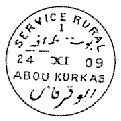 |
Inaugurated in May 1888, the rural post served smaller villages that did not warrant a post office. A postman on foot or donkey carried out a round taking in several villages each with a post-box containing its own oval village indicator (cartouche), which the postman applied there and then clear of the stamps (hence outgoing only). The circular datestamps were applied to cancel the stamp at the main collection office at the end of the round. |
| Savings Bank SB-7 |
 |
Not intended to cancel stamps for postage but for used in childrens savings books in which postage stamps acted as savings stamps. When the book was full the value was credited to the child's account and the stamps cancelled. As with other special purpose types, these cancels are occasionally found used as postmarks on cover. The earliest recorded date is 1922. |
| Sea Post SP.O-4.05 |
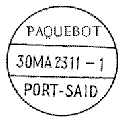 |
The Sea Post is for mail cancelled on ships to and from Egypt and therefore includes cancels on non-Egyptian stamps from shipping lines plying to and from Egypt |
| Stations Sta-13.05 |
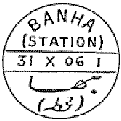 |
These postmarks are for use in post offices mostly in railway stations. Bus stations and seaport terminals have also been recorded with the word station in them |
| Traffic Traf-1.35 |
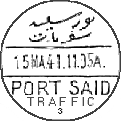 |
Used basically to indicate onward transmission, but just as often seen as the only cancel on a cover. |
| Travelling Post Offices TPO-6.1 |
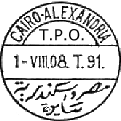 |
Egypt was the one African nation that took to the railways early on, partly because the inhabited areas are all fairly flat. The first TPO began in 1875 between Cairo and Alexandria. This illustration was originally TPO-6.1 but became TPO-5A3 in Peter Smith's 1983 book The Travelling Post Offices of Egypt and then TPO-5A in his Egypt book. The TPO book gives nearly 80 drawings with dates and routes. |
|
|